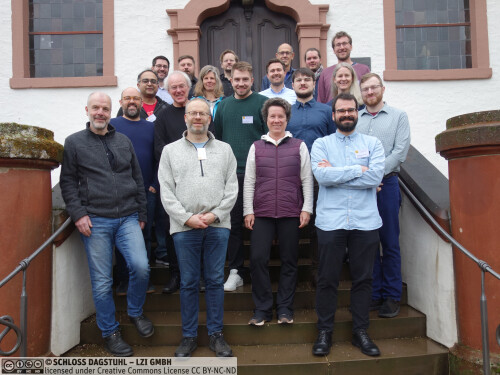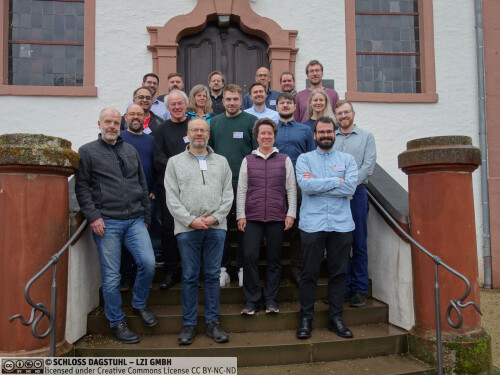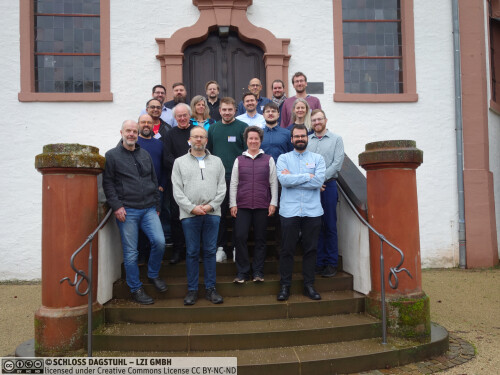Dagstuhl-Seminar 23022
Inverse Biophysical Modeling and Machine Learning in Personalized Oncology
( 08. Jan – 13. Jan, 2023 )
Permalink
Organisatoren
- George Biros (Univ. of Texas at Austin, US)
- Andreas Mang (University of Houston, US)
- Björn H. Menze (Universität Zürich, CH)
- Miriam Schulte (Universität Stuttgart, DE)
Kontakt
- Andreas Dolzmann (für wissenschaftliche Fragen)
- Christina Schwarz (für administrative Fragen)
Programm
Our Dagstuhl Seminar brought together leading experts in computational and applied mathematics, computer science, biomedical imaging, and medical imaging sciences with research interests in data science, machine learning, modeling, optimization, and statistical and deterministic inversion with applications in medical imaging, and - in particular - oncology. Overall, 22 participants (and 5 remote participants) from various scientific disciplines contributed with scientific presentations about their current and future research efforts in these areas.
The seminar had four main thrusts: (i) machine learning in the context of data analytics and data-driven model prediction, (ii) predictive computational modeling through statistical and deterministic inversion, (iii) integration of machine learning with model-based priors, and (iv) use of these methods to aid decision making. We discussed these topics through the lens of foundational algorithmic complications and mathematical and computational challenges. We also explored how advances in the applied sciences (e.g., data analytics, medical imaging, radiomics, genomics, or experimental design) can aid us to tackle challenges associated with the design of computational and mathematical methods.
In the context of predictive computational modeling and deterministic and statistical inversion, we addressed topics ranging from uncertainty quantification, model choices (multiscale versus macroscopic; model-complexity; multispecies versus single-species), regularization strategies, sensitivity analysis, strategies to address the massive computational costs, challenges in the design of hardware-accelerated computational methods with optimal energy efficiency, and strategies to yield the throughput, robustness, and reliability required in practical applications under given hardware constraints. In the context of machine learning and its integration with predictive modeling and priors, we discussed issues associated with limited reproducibility beyond the training data, robustness against outliers, issues with small-sample size problems, uncertainty quantification for learning from data, and generic strategies to enrich the available data. Lastly, we also explored the availability and use of advanced imaging technologies that can help to (i) provide a better data basis for predictive modeling, (ii) trigger community efforts to enrich available data, and (iii) enable validation and standardize population-based studies. We also discussed reproducibility issues, given that in many cases (medical imaging) data is proprietary, challenges associated with the validation of the proposed methodology, and a lack of reproducibility due to the absence of standard protocols for validation of data- and model-driven methods by translational research groups.
The seminar started with opening remarks by two of the main organizers (Biros and Menze). They reviewed their contributions to the field and gave an overview of the state-of-the-art from their perspective. This opened up the floor for a first discussion on where we are and where we would like to go with our future research. During the first two and a half days different scientists contributed to our seminar with presentations about their recent activities and their view on the state-of-the-art. We did not keep a tightly fixed schedule. This allowed participants to engage and discuss the presented material, shed light on potential future research avenues, identify common areas of interest between participants and research groups, as well as exchange ideas on how to address potential shortcomings of the state-of-the-art methods. Overall, this led to an active exchange about open issues, potential solutions, and current activities among participants of our seminar. The topics discussed during the research presentations include computational and mathematical approaches targeted at aiding clinical treatment (with contributions form, e.g., Brüningk, Fuster Garcia, Hormuth, Menze), the design of new mathematical models of cancer/tumor progression (with contributions from, e.g., Biros, Deutsch, Gomez, Menze, Schulte, Wohlmuth), the design and analysis of methodology for machine learning (with contributions from, e.g., Erhardt, Konukoglu, Pati), inverse problems and optimization (with contributions from, e.g., Biros, Erhardt, Latz, Mang, Schulte), scientific machine learning with applications in medical imaging (with contributions from e.g., Brüningk, Erhardt, Fuster Garcia, Konukoglu, Li, Merhof, Van Leemput), hardware-accelerated computational methods, high performance computing, and computational complexity (with contributions from Biros, Mang, Schulte), the integration of modeling integration of data-driven methods with model-driven approaches for predictive modeling (with contributions from, e.g., Biros, Brüningk, Hormuth, Lorenzo, Menze, Schulte, Wiestler), and advances in medical imaging and medical image analysis (with contributions from, e.g., Li, Lundervold, Merhof, Paech, Pati, Van Leemput, Weidner, Wiestler). Several of these contributions are briefly described in the abstracts included in the full report.
As mentioned above, during the discussions after each scientific presentation, we identified several open problems and challenges that we believe should be addressed by the community at large. We briefly list some of the main points raised during these discussions here:
Regarding the integration of computational models with medical imaging, a key challenge is to establish if a model is of use in the clinical context. Many of the available mathematical models are oversimplifications, particularly in the context of modeling cancer progression at a tissue scale. As such, one generic use of these models is to utilize them as "priors" for more classical image analysis tasks such as image segmentation or image registration.
As for generating model-based predictions, a key remaining challenge is how simple or complicated mathematical models need to be, to be of clinical value. While some tasks (e.g., patient classification or tissue characterization) can potentially be helped by simple models, an open question is how complicated models can or have to be to aid clinical decision-making or enable model-based predictions (e.g., if one envisions forecasting the benefit of certain types of clinical intervention in individual patients).
Another key challenge in this context is the scarcity of the available data. Moreover, how do we validate and compare the performance of these approaches and how can we establish good benchmarks to test methods developed by individual research teams? A related open question is, which scale is most suitable to simulate certain aspects of cancer growth/disease progression and/or treatment? Are microscopic rule-based approaches required, or can we utilize coarser, macroscopic models that typically formulate tumor/cancer progression in terms of partial differential equations? Another question is to what extent and if physics-informed methods (i.e., methods based on the simulation of biophysical phenomena) add significant value to clinical diagnosis and treatment planning versus more standard, machine learning-based predictions generated from features derived from imaging data. One key question that was also discussed in this context was how these methods are plagued by model and data uncertainties.
Moreover, we discussed how to integrate modeling with machine learning in the most efficient way. Can we, e.g., use machine learning as a tool to initialize more classical (e.g., variational) methods for inference of model parameters and/or integration of simulation with data? Conversely, can machine learning benefit from an integration of physics-based principles prescribed by biophysical models? Likewise, can machine learning be used as a tool to improve model selection, i.e., can we use it to decide how complex a mathematical model needs to be?
From an imaging perspective, one question that arose was how to combine different types of data (e.g., structural imaging, biomedical markers, radiomics, functional imaging, patient questionnaires) most effectively. In many studies, one typically does not integrate information from multiple sources but relies on specific types of medical data. Would such a more complete integration aid model-based predictions? How does the designed methodology generalize for data acquired at different imaging sites and/or imaging modalities? Another key issue is the scarcity of publicly available (good quality) data and how to address it as a community. One solution presented at the seminar was the use of federated learning.
Lastly, if we envision pushing these methods toward clinical applications, how can we deal with low-performance computing infrastructure at clinical sites? We also discussed clinical scenarios for applying the designed methods and how they could be of use in clinical practice (for example, to plan a therapeutic intervention or post-therapy assessment).
On Wednesday, we engaged participants in scientific discussions during an excursion to an art show at the "Völklinger Hütte". We concluded this social event with a joint dinner in one of the local restaurants.
The scientific presentations were followed by a brief discussion about selected topics in two working groups to identify immediate goals and further discuss existing challenges. The first group included researchers with a key interest in designing methods to analyze medical (imaging) data and integrate mathematical and computational methods with imaging and medical data. The second group discussed topics associated with the design of mathematical and computational methods for inference, simulation, and optimization. We list the key findings in these two groups and some of the questions that remain to be addressed by the community at large in the report. We concluded our seminar with a plenary discussion about the findings of our working group discussions. This enabled us to identify commonalities toward a more concrete outline of follow-up work after the conclusion of our seminar. As a first concrete goal for the entire group, we agreed that we should start our work with a joint (public) dataset that compiles available medical imaging data for model development and testing. Spearheaded by Gomez and Hormuth, a first list of publicly available data was curated on the Mathematical Oncology webpage: https://mathematical-oncology.org/resources/datasets. Moreover, they have started to collect information for relevant conferences and workshops of interest for the community at large (https://mathematical-oncology.org/conferences).
 George Biros, Andreas Mang, Björn H. Menze, and Miriam Schulte
George Biros, Andreas Mang, Björn H. Menze, and Miriam Schulte
Our Dagstuhl Seminar aims to bring together leading experts in mathematical, computational, and biomedical, and medical imaging sciences with research interests in data science, machine learning, modeling, optimization, and (statistical) inversion with applications in (but not limited to) medical imaging, and in particular oncology. A central theme of our seminar is the integration of data-driven methods (i.e., machine learning) with model-driven approaches (e.g., biophysical priors and statistical inversion) for predictive modeling. We hypothesize that this integration allows us to augment the available data for training, achieve more generalizable data-driven models, and obtain results that are more interpretable.
The seminar has four main thrusts: (i) machine learning in the context data analytics and data-driven model prediction, (ii) predictive computational modeling through (statistical) inversion, (iii) integration of machine learning with model-based priors, and (iv) use of these methods to aid decision making. We want to discuss these topics through the lens of foundational algorithmic complications and mathematical and computational challenges. We will explore how advances in the applied sciences (e.g., data analytics, medical imaging, radiomics, genomics, or experimental design) can aid us to tackle these challenges.
The overarching issues are robustness of computational methods, generalizability, reproducibility, reliability, algorithmic complexity, performance optimization, shared and distributed memory parallelization, mixed-precision algorithms, scalability, hardware acceleration, software deployment (in parallel/hybrid computing architectures), augmentation of data, and software premises for developing open-source packages for the research community at large. Our premise is to compare performance in terms of a holistic view, including theoretical properties, runtime efficiency, and parallel scalability, but also sustainability and suitability for energy-efficient and comparably cheap accelerator hardware such as graphics processing units.
In the context of predictive computational modeling and statistical inversion, we plan to address topics ranging from uncertainty quantification, model choices (multiscale versus macroscopic; model-complexity; multispecies versus single-species), regularization strategies, sensitivity analysis, strategies to address the massive computational costs (e.g., reduced-order modeling, sampling strategies, optimization algorithms), challenges in the design of hardware-accelerated computational methods with optimal energy efficiency, and strategies to yield the throughput, robustness, and reliability required in practical applications under given hardware constraints. In the context of machine learning and its integration with predictive modeling and priors, we want to cover topics ranging from (stochastic) algorithms for non-convex optimization, regularization strategies, issues with limited reproducibility beyond the training data, robustness against outliers, issues with small-sample size problems (e.g., how to reliably train complex networks), uncertainty quantification for learning from data through the lens of models under data and model uncertainty, model-based data augmentation for data-driven approaches, data augmentation to alleviate issues with reliability and generalizability, and generic strategies to enrich the available data. Lastly, we intend to identify new imaging avenues that can help to (i) provide a better data basis for predictive modeling, (ii) trigger community efforts to enrich available data, and (iii) enable validation and standardize population-based studies. We want to address reproducibility issues, given that in many cases (medical imaging) data is proprietary. We plan to discuss the significant challenges associated with the validation of the proposed methodology, and a lack of reproducibility due to the absence of standard protocols for validation of data- and model-driven methods by translational research groups (in clinical oncology).
 George Biros, Andreas Mang, Björn H. Menze, and Miriam Schulte
George Biros, Andreas Mang, Björn H. Menze, and Miriam Schulte
- Michal Balcerak (Universität Zürich, CH)
- George Biros (Univ. of Texas at Austin, US) [dblp]
- Sarah Brüningk (ETH Zürich - Basel, CH)
- Malte Brunn (Universität Stuttgart, DE)
- Andreas Deutsch (TU Dresden, DE) [dblp]
- Matthias J. Ehrhardt (University of Bath, GB) [dblp]
- Elies Fuster Garcia (Technical University of Valencia, ES)
- David Hormuth (Univ. of Texas at Austin, US)
- Ender Konukoglu (ETH Zürich, CH) [dblp]
- Jonas Latz (Heriot-Watt University - Edinburgh, GB)
- Guillermo Lorenzo (University of Pavia, IT & UT Austin, US)
- Arvid Lundervold (University of Bergen, NO)
- Andreas Mang (University of Houston, US) [dblp]
- Björn H. Menze (Universität Zürich, CH) [dblp]
- Dorit Merhof (Universität Regensburg, DE) [dblp]
- Daniel Paech (Universitätsklinikum Bonn, DE)
- Sarthak Pati (University of Pennsylvania, US)
- Miriam Schulte (Universität Stuttgart, DE) [dblp]
- Koen Van Leemput (Martinos Center - Charlestown, US) [dblp]
- Jonas Weidner (TU München - Klinikum rechts der Isar)
- Benedikt Wiestler (TU München - Klinikum rechts der Isar, DE) [dblp]
- Barbara Wohlmuth (TU München - Garching, DE) [dblp]
- Atle Bjornerud (University of Oslo, NO)
- Chao Li (University of Cambridge, GB)
- Jana Lipkova (Harvard University - Boston, US) [dblp]
- Assad Oberai (USC - Los Angeles, US)
- Russell Rockne (City of Hope - Duarte, US)
Klassifikation
- Computer Vision and Pattern Recognition
- Machine Learning
- Mathematical Software
Schlagworte
- Medical Image Analysis
- Image Segmentation
- Inverse Problems
- Tumor Growth Simulation and Modeling
- Machine Learning
- Parallel Computing




 Creative Commons BY 4.0
Creative Commons BY 4.0
